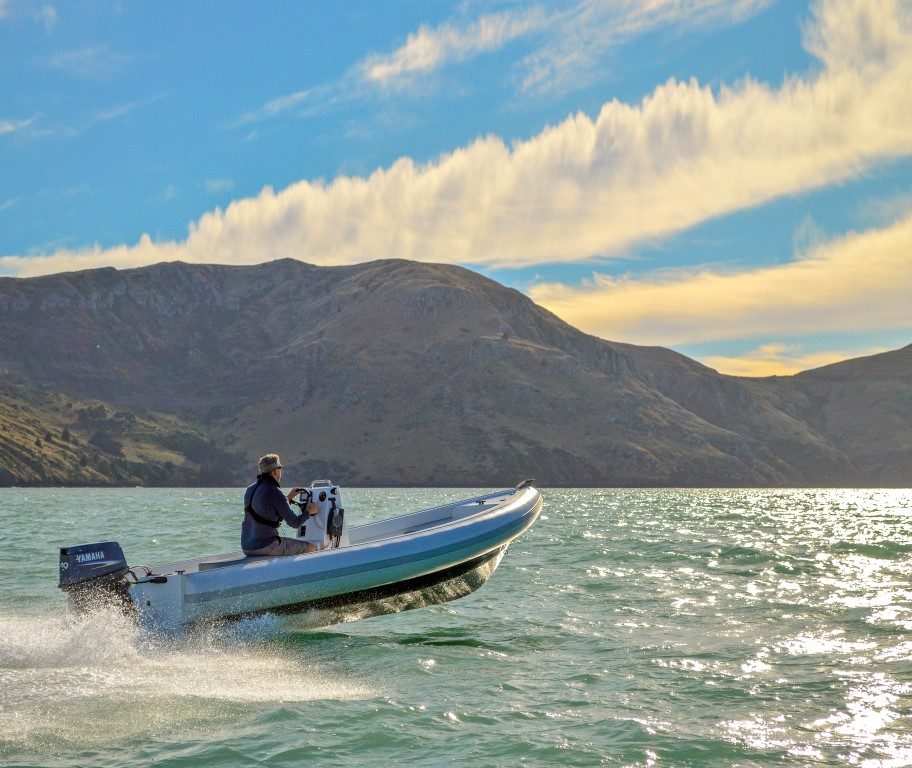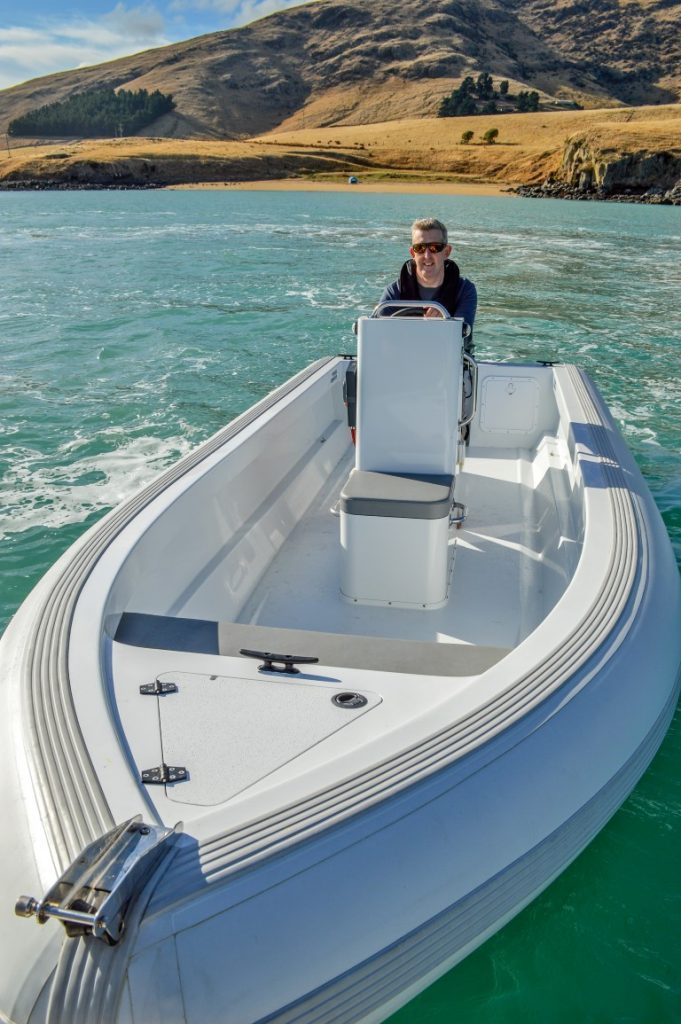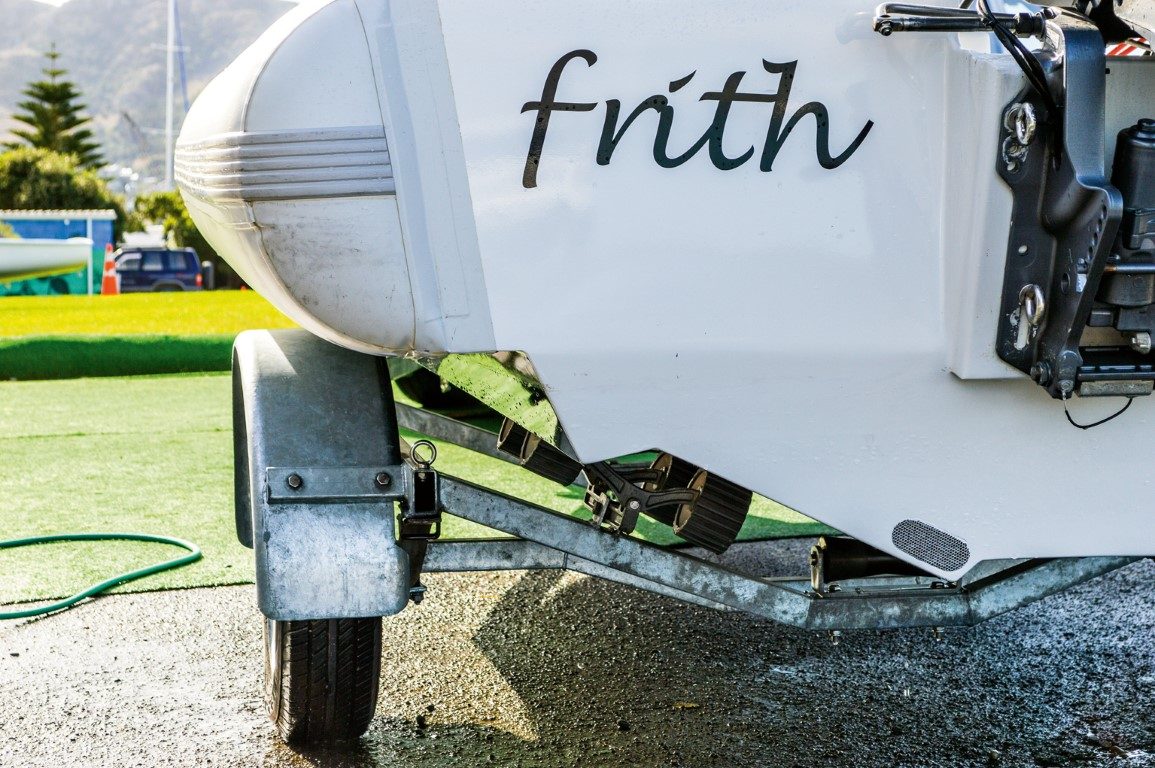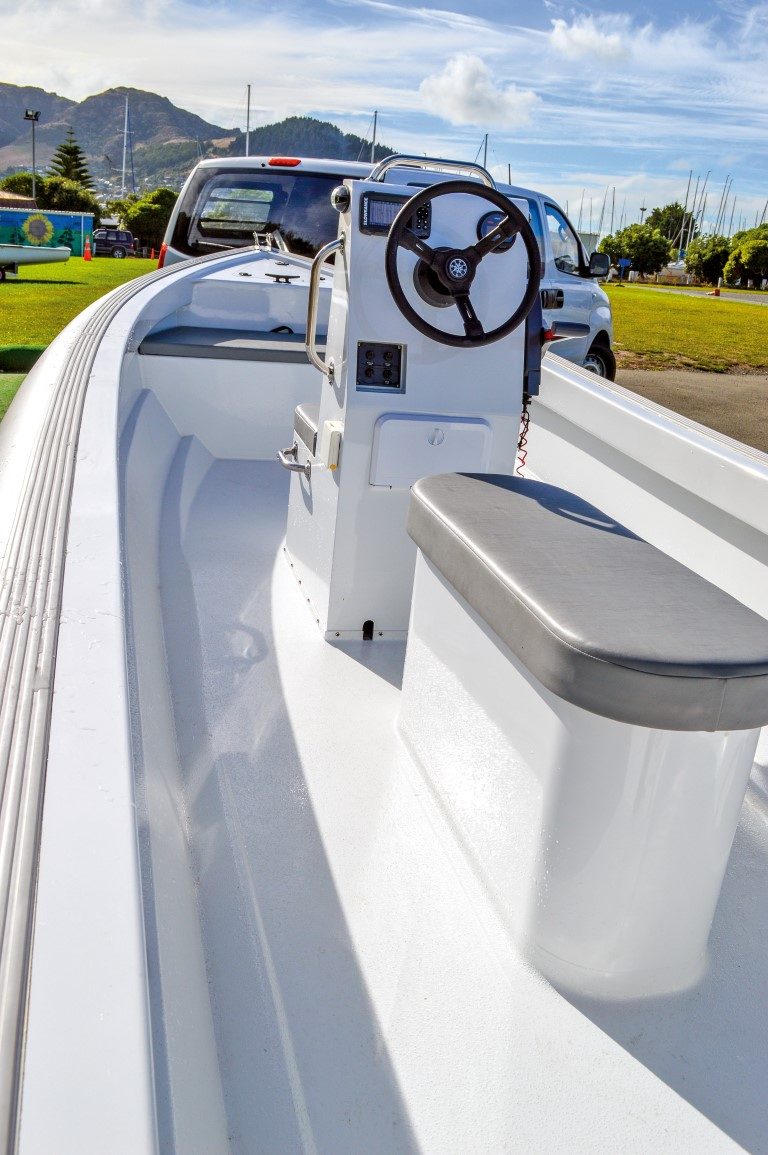‘Behemoth’ is a word which springs to mind or, perhaps more nautically, ‘leviathan’.
- Exceptionally dry ride
- Easily-driven hull
- Soft riding
- Open layout
- Narrow beam

I knew something was up when Milton Bloomfield, managing director of Dynamic Composites turned up for the boat review in a pair of shorts and T-shirt.
We were going for a blast in his latest prototype 5.2m RIB on Lyttelton Harbour in a sloppy easterly swell. I was dressed for a drenching in my full wet weather gear. It was a fashion decision based on my previous spray-soaked experience in RIBs.
I felt like I’d turned up at Hawaiian-themed dress-up party in tails and a top hat. A mildly embarrassing feeling that was soon put to one side as I was introduced to the boat. Frith, as she has is called, is the second prototype of a RIB design that is set to change the game.

As an engineer by training, Milton often comes across things that could be better with a bit of design thinking. He’s done this numerous times with such things as bikes, kayaks, and ski equipment. Having spent a lot of time on the water as a sailing coach and judge it was a natural progression for the humble RIB to fall under his well-calculated gaze.
Construction
Dynamic Composites is a firm with a well-deserved international reputation in the production and design of custom carbon miracles, ranging from medal-winning bicycles and skis to America’s Cup components. Boat production is not its core business, but excellent design is and the 5.2m RIB is set to be yet another of its success stories.

Frith is constructed in corecell panels laid up over male frames with E-glass epoxy inside and out. The flat panel system fits together like origami and it’s a good building method for a one-off prototype. The Mk 3 model is already in the design phase and will be configured in a female mould to allow for a production line and different build specs from all-out carbon epoxy to a more sedate polyester glass combination.
“When you build a boat for yourself you tend to over-engineer things,” says Milton. Beneath the floor is a lattice of three fibreglass frames spaced over two longitudinal girders. The result is a very stiff and strong hull that will take the punishment.
Layout
The first thing you notice about Frith is that she is more rigid than inflatable. The D-tubes sit high on the boat above the static waterline and while they provide a backup for stability in an extreme roll scenario, they are mostly only there as fenders for coming alongside. Once you realise the hull is doing all the work your eyes are naturally drawn down to the detail.
The hull’s long and narrow. With an external beam of two metres and an internal beam of 1.4m she has the pedigree of the ubiquitous South Pacific Island long boat. These long boats are known for their heroic ability to keep a sea in an overloaded state and their ease of propulsion. While the heritage is there, it is the refinements in the hull that take Frith into the realms of the modern fun machine.
Not far below the PVC D-tubes lurks the first of the chines, which is carried all the way to the tapered bow sections. This chined hull resembles the channel bottom surfboard designs of the late 1980s and its base allows the boat to settle in static mode and its forward sections divert a lot of spray while providing some good form stability when it’s needed.

Below this chine, the hull takes a steep dive into a deep vee which starts as a 25°deadrise at the stern and is closer to 43° around the helm station section of the boat. Much of Frith’s great ride and sea keeping comes from this deep vee section, which has been carefully tweaked over the first two prototypes.
At the stern, the vee terminates in a delta flat that enables the cavitation plate of the engine to line up with its lower face. This, along with the transom design, avoids having to have an excessive long engine shaft to get past the bottom of the vee and keeps the draft at a comfortable 300mm.
At the aft end of the delta flat are the two oval drains for the 285-litre flood tank. The tank helps the static stability and brings the hull at rest down onto the substantial chines, nicely getting around the potential tenderness of the narrow hull. The drains aided by a breather that exits under the seat allows the flood tank to drain rapidly once underway.
Despite the narrow beam, there’s plenty of walkaround room on this boat. The centre console is a bolt-on unit under which is a plastic 45-litre petrol tank. A forward seat is integrated into its form.

On the business end of the console is the side-mounted Yamaha engine controls with plenty of room for the Lowrance depth sounder and engine readout display. The longitudinal seat behind the helm console has gaps both at the forward and aft ends, which aid deck flow and allow the option of standing or sitting for the helmsperson.
The D-tubes fit flush with the deck allowing a clean edge which enhances the spacious feel of the hull platform. The boat’s transom is substantial and allows for holding station and backing up which are an essential feature in a coach boat.
Mounted on the transom is an ancient two-stroke Yamaha 40hp spinning an 11⅔ x 12-inch prop. This was a Bloomfield family heirloom requisitioned to get the boat in the water and the narrow, easily-driven hull means that this is all that’s needed to get her moving.
On the Water
After the fashion fiasco of our first introduction, we set out into a late summer morning full of easterly slop. The smaller Mk I prototype, which usually serves its time as one of the Naval Point Club’s coach boats, was kindly offered as the photo boat.
It quickly became apparent that Milton’s dress sense was based on sound reasoning and not the fickle whims of fashion. Charging up harbour in Frith, he sat in a dry majesty, the narrow hull showing its ability to handle a sea state that would have had most production powerboats throttling off to avoid violent slamming.
The helm position looked to be at the longitudinal balance point of the hull and it did not seem to matter whether it was a slow pass or flat-out speed run: the boat sat on trim and was dry with no pounding.
Most of my time in powerboats is spent taking photos for this magazine. In lumpy conditions, I usually resort to holding station while the boat on review makes passes. Such was the sea-keeping ability of the Mk1 that we were able to take running shots without drenching the photographer or pounding ourselves to death.
With the photos and the talking done, Milton did an unusual thing for a boat test. Instead of nervously hovering over me on the helm while I put the boat through its paces, he and camera boat driver Danny left me to it and motored back to the ramp in the photo boat.

I was like a kid who’d got the keys to dad’s car. I tried every combination, upwind, downwind, crosswind and low speed. I tried out holding position, backing up and laying down turns intent on finding some weakness in the design. I pushed hard downwind trying to slam the boat into the wave in front. I pushed hard in all directions waiting to find some limit or hint of bad behaviour. I found none.
I could baffle you with numbers and say at 3,300rpm we got 17 knots cruising speed and at 4,900 we got a top speed of 28 knots but that would be missing the point. Frith is more about the way it feels to be on the water than the numbers. My wet weather gear remained dry and I spent way too long out there having a hoot of a time.
While most production powerboat manufacturers spend fortunes on marketing and hype, I think Dynamic Composites is going to have a much simpler and effective plan for its 5.2m RIB. It will be ‘try it and you will buy it.’ If they throw in a complimentary Hawaiian shirt and board shorts to wear aboard they’ll have it sold.
‘Behemoth’ is a word which springs to mind or, perhaps more nautically, ‘leviathan’.
White Pointer has earned the respect of discerning customers in New Zealand and Australia, attracting a loyal and ever growing following for its high-quality, rugged and totally dependable aluminium trailer boats.
The hardtop SP635 shares the same underpinnings as the popular SF 635 which was a completely new model back in 2020.
The pride and joy of a multi-generational family, Bliss resides on a pier that’s home to a couple of other Elite motor launches – Sandspit Marina is a hot-spot for the Bill Upfold-designed vessels, with several calling this small marina home.